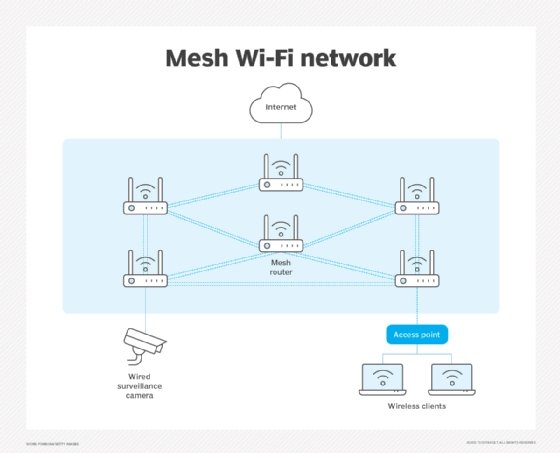wireless mesh network (WMN) (original) (raw)
What is a wireless mesh network (WMN)?
A wireless mesh network (WMN) is a mesh network created through the connection of wireless access point (WAP) nodes installed at each network user's locale. The networking infrastructure is decentralized and simplified because each node need only transmit as far as the next node. WMNs may or may not be connected to the internet.
Mesh networks can be used for any application where network end nodes are too far apart to share direct access to a central location, such as an internet connection. Any type of network protocol can be used throughout the network.
Wi-Fi is widely used for home or office networks, but other types of networks may be used for other applications. Bluetooth and Zigbee are short-distance protocols that require less power than Wi-Fi and are used to link battery-operated devices. Longer distances between nodes may require wireless administrators to link nodes with a network technology that has greater distance capabilities.
Wireless mesh networks, which can also be a form of wireless ad hoc network, are often used for the following:
- home Wi-Fi networks;
- public Wi-Fi access provided by cities and municipalities;
- Wi-Fi and networking in temporary locations, such as construction sites;
- connecting internet of things devices, such as sensors, security systems, smart appliances and monitoring systems;
- building networks in developing communities that lack internet wiring infrastructure; and
- providing consistent wireless access to hospitals, educational campuses and warehouses.

An example of a wireless mesh network configuration
How do wireless mesh networks work?
Wireless mesh networks work through mesh nodes, mesh clients and gateways:
- Mesh nodes are WAP devices with multiple radio systems. Nodes act as mesh routers and endpoints. Firmware enables them to share data between other nodes in the network.
- Mesh clients are wireless devices, such as laptops, mobile phones and tablet computers.
- Gateways are nodes that connect two networks using different protocols. Data passes through the gateway as it enters or exits a network.
Each node in a WMN has at least one path -- but often multiple -- to other nodes, which creates multiple routes of information for pairs of users. This makes the network more resilient, and in the event of a WAP or connection failure, information can still access other nodes.
The network topology of a wireless mesh network may be full or partial mesh. A full mesh network means every node communicates with every other node. In a partial mesh topology, nodes only communicate with nearby nodes. When data is transmitted between two nodes that do not communicate with each other, data hops from one node to the next until it reaches the client. The nodes are programmed to use adaptive routing algorithms to constantly determine the optimal route between nodes for data transmission.
In a wireless mesh network, each node receives data from one node while forwarding data to the next node. The resulting network between connected devices is often called a mesh cloud. Having more nodes increases the range of the network that the mesh client devices can connect to for internet. Only one node needs to act as a gateway to and from the internet for connectivity.
Advantages of wireless mesh networks
Compared to traditional Wi-Fi routers, wireless mesh networks offer the following advantages:
- They require only one node in the network to be physically wired for internet connection.
- They provide collaborative, redundant backup technology, which ensures data security in the event of disk failure.
- They can be configured dynamically for speed.
- They use less power.
- They offer increased reliability, as each node is connected to several other nodes. If one node drops out of the network, its neighbors simply find another route.
- They use the same set of standards as most Wi-Fi networks -- 802.11a, b and g.
- They are scalable, as it's typically easy to add nodes to the network.
- They can effectively provide coverage to home Wi-fi mesh networks without reducing bandwidth, unlike Wi-Fi range extenders.
Disadvantages of wireless mesh networks
Using a wireless mesh network also comes with downsides:
- Networks with low processing capabilities may have more latency, as data must often hop through several different nodes.
- The lack of a central server can make mesh systems more complicated to monitor, control and troubleshoot.
- The lack of centralization can make routing and resource management processes more complex than with other types of wireless networks.
- Initial network setup can be complex, as ideal node placement across different points in the area likely involves some trial and error.
- For homes, node devices can be less cost-effective than traditional router/modem Wi-Fi networks.
Wireless administrators can use wireless mesh networks for a variety of applications because they're independent of network type. Network operations remain the same whether a short-distance network technology links the nodes or a long-distance technology supports nodes spread further apart. As a result, administrators can quickly update mesh networks as they introduce new or improved wireless technologies.
Explore the four main types of wireless networks.
This was last updated in October 2022
Continue Reading About wireless mesh network (WMN)
- The 4 different types of wireless networks
- Wireless network capacity planning and requirements
- Steps for wireless network planning and design
- Wireless security: WEP, WPA, WPA2 and WPA3 differences
- An overview of wireless WAN
Dig Deeper on Mobile and wireless networks
- Nokia lights up Beacon Wi-Fi 7 gateway
 By: Joe O’Halloran
By: Joe O’Halloran -
 Qualcomm allies with Airties for 5G fixed wireless, home Wi-Fi
Qualcomm allies with Airties for 5G fixed wireless, home Wi-Fi  By: Joe O’Halloran
By: Joe O’Halloran - WBA releases standardised technical framework for operator-managed Wi-Fi
 By: Joe O’Halloran
By: Joe O’Halloran - RDK, Telenet up the ante on Wi-Fi management and performance
 By: Joe O’Halloran
By: Joe O’Halloran